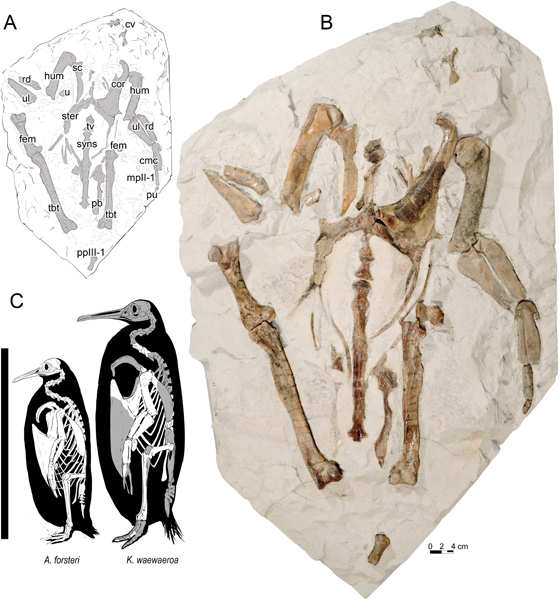New Giant Penguin from New Zealand
Fossils discovered on a beach by a group of school children on a field trip have been identified as a new species of giant, prehistoric penguin. The 1.4-metre-tall bird has been named Kairuku waewaeroa and it hunted fish in the waters off New Zealand’s North Island some 30 million years ago.
The ancestors of today’s penguins (Sphenisciformes), probably lived alongside those other famous archosaurs – the Dinosauria Penguins Probably Lived Alongside Dinosaurs. Fossils of penguins are known from the Palaeocene and over the last few years, palaeontologists have been able to build up arguably, the most complete and continuous fossil record of any type of bird. The new giant penguin K. waewaeroa comes from the Glen Massey Formation and the fossils found by the school children on a Hamilton Junior Naturalist Club (JUNATS) field trip to Kawhia Harbour, North Island in 2006, represents one of the most complete prehistoric penguin specimens found to date.

CT Scans Used to Create Three-dimensional Models
The partially articulated fossil material consisting of limb bones, cervical vertebrae and the pelvis preserved in a single block was presented to Waikato Museum Te Whare Taonga o Waikato, Hamilton, New Zealand in 2017. The research team studying the fossil bones, who included Simone Giovanardi and Daniel Thomas (Massey University, Auckland) and Daniel Ksepka (Connecticut, USA), used CT scans to create three-dimensional computer models. These computer models could then be used to make a 3D-printed replica which was presented to the Hamilton Junior Naturalists.

Giant Penguin with Long Legs
Co-author of the scientific paper, published in the Journal of Vertebrate Paleontology, Dr Daniel Thomas (School of Natural and Computational Sciences at Massey University), stated the fossil dates from between 27.3 and 34.6 million years ago, a time when much of this area of North Island was underwater.
The Senior Lecturer in Zoology added:
“The penguin is similar to the Kairuku giant penguins first described from Otago but has much longer legs, which the researchers used to name the penguin waewaeroa – Te reo Māori for “long legs”. These longer legs would have made the penguin much taller than other Kairuku while it was walking on land, perhaps around 1.4 metres tall and may have influenced how fast it could swim or how deep it could dive.”
To read our article on a monster Palaeocene penguin from New Zealand: Monster Palaeocene Penguin from New Zealand.
Everything Dinosaur acknowledges the assistance of a media release from Massey University in the compilation of this article.
The scientific paper: “A giant Oligocene fossil penguin from the North Island of New Zealand” by Simone Giovanardi, Daniel T. Ksepka and Daniel B. Thomas published in the Journal of Vertebrate Paleontology.
The award-winning Everything Dinosaur website: Dinosaur Toys.

